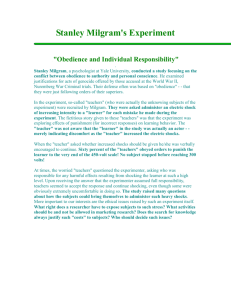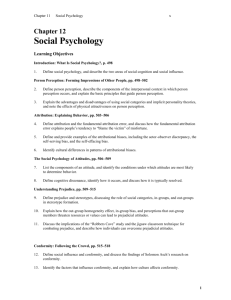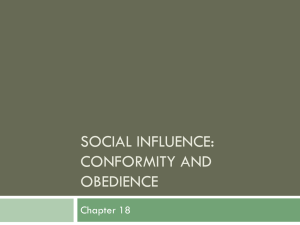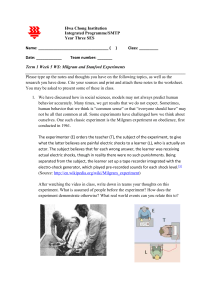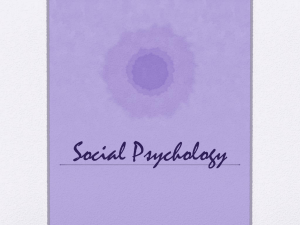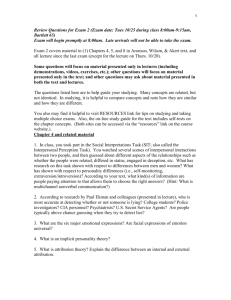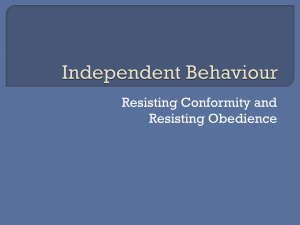Figures not included
advertisement
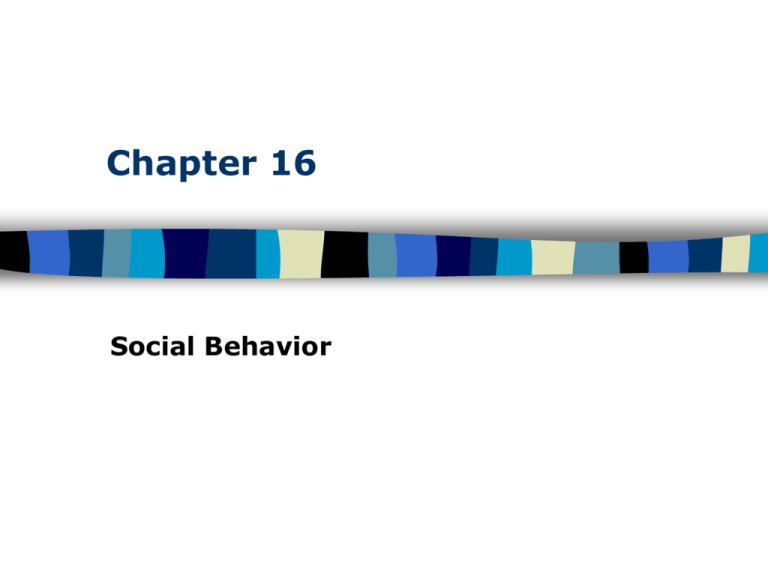
Chapter 16 Social Behavior When an observer is biased in favor of making internal attributions in explaining others' behavior, the observer is making a . b . c . d . a stereotypical error the self-serving error the self-effacing error the fundamental attribution error Table of Contents When an individual has a tendency to attribute his/her success to personal factors and his/her failure to situational factors, the individual is demonstrating a . b . c . d . the fundamental attribution bias the self-effacing bias the self-serving bias defensive attribution Table of Contents ANSWERS: D C Table of Contents Social Psychology Person perception Attribution processes Interpersonal attraction Attitudes Conformity and obedience Behavior in groups Table of Contents Person Perception: Forming Impressions of Others Effects of physical appearance Cognitive schemas – age, profession, ethnicity Stereotypes – learned Prejudice and discrimination-attitude vs. action Subjectivity in person perception Evolutionary perspectives – stereotypes separate friend from foe – spotlight effect – illusion of asymmetric insight Table of Contents Table of Contents Table of Contents Attribution Processes: Explaining Behavior Attributions – Internal vs. External Biases in attributions – Fundamental attribution error – Defensive attribution – blaming the vicitim – Self-serving bias Cultural influences – individualistic - self-serving and fundamental att. err. – collectivistic Table of Contents Figure 16.1 Causes of Success and Failure: Attribution Table of Contents Table of Contents Table of Contents In regards to interpersonal attraction, which of the following sayings is most accurate? a . b . c . d . opposites attract he who hesitates is lost to know me is to love me birds of a feather flock together Table of Contents Which of the following is not one of the major components of an attitude? a . b . c . d . cognitive perceptual affective behavioral Table of Contents A person experiences an unpleasant state of tension when related attitudes or beliefs are inconsistent or contradict each other according to a . b . c . d . the persuasion model the elaboration likelihood model cognitive dissonance theory observational learning Table of Contents ANSWERS: D B C Table of Contents Learning To Love Eating Grasshoppers Zimbardo, Weisenberg, Firestone, and Levy (1965) demonstrated that “nice guys” as sources for persuasive messages can be less persuasive than “nasty guys.” The study involved ROTC students, military reservists, and college students. They were told that the study was about survival skills needed for the "new mobile military." A key survival skill needed was to experience and develop a taste for novel foods (specifically, grasshoppers.) There were two major conditions in the study: A ‘Nice Guy’ condition and a ‘Nasty Guy’ condition. The ‘Nice Guy’ entered the room with a warm greeting, pleasantly interacted with the other people in the room, and expressed sensitivity for the participant’s discomfort. The ‘Nasty Guy’ startled the people in the room with an abrupt and demanding entrance. He was gruff and rude in demeanor and he went out of his way to berate the ‘assistants’ in the room. In the end, the people in the ‘Nasty Guy’ condition professed much greater liking for grasshoppers as food than the people in the ‘Nice Guy’ condition. Some even took extra grasshoppers home to share with their friends and family. WHY? Table of Contents With the ‘Nice Guy’ the dissonance produced between disliking grasshoppers and eating them could be reduced by thinking that they ate the grasshoppers because the speaker was such a nice guy. Therefore, there was no need to change their feelings about the grasshoppers. With the ‘Nasty Guy’ the dissonance produced between disliking grasshoppers and eating them could NOT be reduced by thinking that they ate the grasshoppers because of the speaker: he was a jerk. The only way to reduce the dissonance was to change their attitudes about eating grasshoppers to be consistent with their grasshopper eating behavior. Zimbardo, P. G., Weisenberg, M., Firestone, I., & Levy, B. (1965). Communicator effectiveness in producing public conformity and private attitude change. Journal of Personality, 33, 233-255. Table of Contents Table of Contents Close Relationships: Liking and Loving Key factors in attraction – – – – – – Physical attractiveness Matching hypothesis Similarity Reciprocity - self-enhancement Romantic Ideals Proximity Perspectives on love – Hatfield & Berscheid – Passionate vs. Companionate love – Sternberg - Intimacy and commitment fig. 16.4 – Hazen & Shaver – love as attachment fig. 16.5 Evolutionary perspectives – Mating priorities – reproductive fitness Table of Contents Social Relations- Attractiveness Proximity Geographic nearness– perhaps the most powerful indicator of friendship. Proximity provides opportunities for aggression, but much more often it breeds liking. People are most likely to like, and even to marry, those who live in the same neighborhood, who sit nearby in class, who work in the same office, who share the same parking lot. Table of Contents Social RelationsAttractiveness Mere Exposure Effect repeated exposure to novel stimuli increases liking of them Conceptions of attractiveness vary by culture Table of Contents Social Relations- Attractiveness Similarity We are likely to become friends with other who are similar to us in attitudes, intelligence, age, and economic status. Similarity breeds content. Table of Contents Social Relations Passionate Love an aroused state of intense positive absorption in another usually present at the beginning of a love relationship Companionate Love deep affectionate attachment we feel for those with whom our lives are intertwined Table of Contents Figure 16.4 – Sternberg’s view of love over time Figure 16.5 Table of Contents Attitudes and Attitude Change 3 components – cognitive, affective, and behavioral Factors in changing attitudes – source, message, and receiver – two sided arguments and fear arousal are effective Theories of attitude change – Learning theory - classical conditioning, operant conditioning, and observational learning. – Cognitive Dissonance theory – Self-perception theory - people infer their attitudes from their behavior – Elaboration likelihood model – central route to persuasion Table of Contents Table of Contents Table of Contents Table of Contents Table of Contents Yielding to Others: Conformity Conformity – Solomon Asch (1950s) – Classic experiment • Group size – larger groups increase conformity • Group unanimity – one dissenter makes subject less likely to conform Table of Contents Social Influence 50% Difficult judgments 40 Percentage of conformity to confederates’ wrong answers Conformity highest on important judgments 30 20 10 Easy judgments Participants judged which person in Slide 2 was the same as the person in Slide 1 0 Low High Importance Table of Contents Table of Contents Yielding to Others: Obedience Obedience – Stanley Milgram (1960s) – Controversial landmark experiment – “I was just following orders” • Milgram found that 65% of the men administered all 30 levels of the shock, even though they displayed considerable distress at shocking the learner. Table of Contents Obedience Obedience – compliance of person is due to perceived authority of asker – request is perceived as a command Stanley Milgram Milgram interested in unquestioning obedience to orders Table of Contents Stanley Milgram’s Studies Basic study procedure – teacher and learner (learner always confederate) – watch learner being strapped into chair – learner expresses concern over his “heart condition” Table of Contents Stanley Milgram’s Studies Teacher goes to another room with experimenter Shock generator panel – 15 to 450 volts, labels “slight shock” to “XXX” Asked to give higher shocks for every mistake learner makes Table of Contents Stanley Milgram’s Studies Learner protests more and more as shock increases Experimenter continues to request obedience even if teacher balks 120 “Ugh! Hey this really hurts.” 150 “Ugh! Experimenter! That’s all. Get me out of here. I told you I had heart trouble. My heart’s starting to bother me now.” 300 (agonized scream) “I absolutely refuse to answer any more. Get me out of here. You can’t hold me here. Get me out.” 330 (intense & prolonged agonized scream) “Let me out of here. Let me out of here. My heart’s bothering me. Let me out, I tell you…” Table of Contents Table of Contents Obedience Percentage of subjects who obeyed experimenter 100 90 80 70 60 50 40 30 20 10 0 The majority of subjects continued to obey to the end Moderate Very Extreme XXX Slight (75-120) Strong strong Intense intensity Danger (435-450) (15-60) (135-180) (195-240) (255-300) (315-360) severe (375-420) Shock levels in volts Table of Contents Table of Contents Explanations for Milgram’s Results Abnormal group of subjects? – numerous replications with variety of groups shows no support People in general are sadistic? – videotapes of Milgram’s subjects show extreme distress Table of Contents Follow-Up Studies to Milgram Table of Contents Critiques of Milgram Although 84% later said they were glad to have participated and fewer than 2% said they were sorry, there are still ethical issues Do these experiments really help us understand real-world atrocities? Table of Contents Social Relations Ingroup Bias tendency to favor one’s own group Scapegoat Theory theory that prejudice provides an outlet for anger by providing someone to blame Just-World Phenomenon tendency of people to believe the world is just people get what they deserve and deserve what they get\ explains ‘blaming the victim’ Table of Contents Social Thinking Foot-in-the-Door Phenomenon tendency for people who have first agreed to a small request to comply later with a larger request Role set of expectations about a social position defines how those in the position ought to behave Table of Contents Behavior in Groups: The Influence of Other People The bystander effect - Darley and Latane (1968) – Kitty Genovese – Diffusion of responsibility Group productivity and social loafing Decision making in groups Polarization Groupthink Deindividuation loss of self-awareness and self-restraint in group situations that foster arousal and anonymity Table of Contents Social Influence Some individual resist social coercion Table of Contents Social Facilitation Table of Contents Groupthink Eight warning signs of groupthink: The illusion of invulnerability Belief in the inherent group morality Rationalization of group views Stereotyping of out-groups Self-censorship Direct pressure on dissenters Self-appointed mindguards The illusion of unanimity Four key preventative strategies: Establish an open climate Avoid the isolation of the group Assign the role of critical evaluator Avoid being too directive Table of Contents Social Influence Superordinate Goals shared goals that override differences among people and require their cooperation Social Facilitation improved performance of tasks in the presence of others occurs with simple or well-learned tasks but not with tasks that are difficult or not yet mastered Social Loafing tendency for people in a group to exert less effort when pooling their efforts toward attaining a common goal than when individually accountable Table of Contents Social Relations Bystander Effect tendency for any given bystander to be less likely to give aid if other bystanders are present Table of Contents Social Influence If a group is likeminded, discussion strengthens its prevailing opinions Table of Contents Table of Contents Table of Contents Social Relations Ingroup “Us”- people with whom one shares a common identity Outgroup “Them”- those perceived as different or apart from one’s ingroup Table of Contents Social Identity and Cooperation Social identity theory – states that when you’re assigned to a group, you automatically think of that group as an in-group for you – Sherif’s Robbers Cave study • 11–12 year old boys at camp • boys were divided into 2 groups and kept separate from one another • each group took on characteristics of distinct social group, with leaders, rules, norms of behavior, and names Table of Contents Robbers Cave (Sherif) Leaders proposed series of competitive interactions which led to 3 changes between groups and within groups – within-group solidarity – negative stereotyping of other group – hostile between-group interactions Table of Contents
